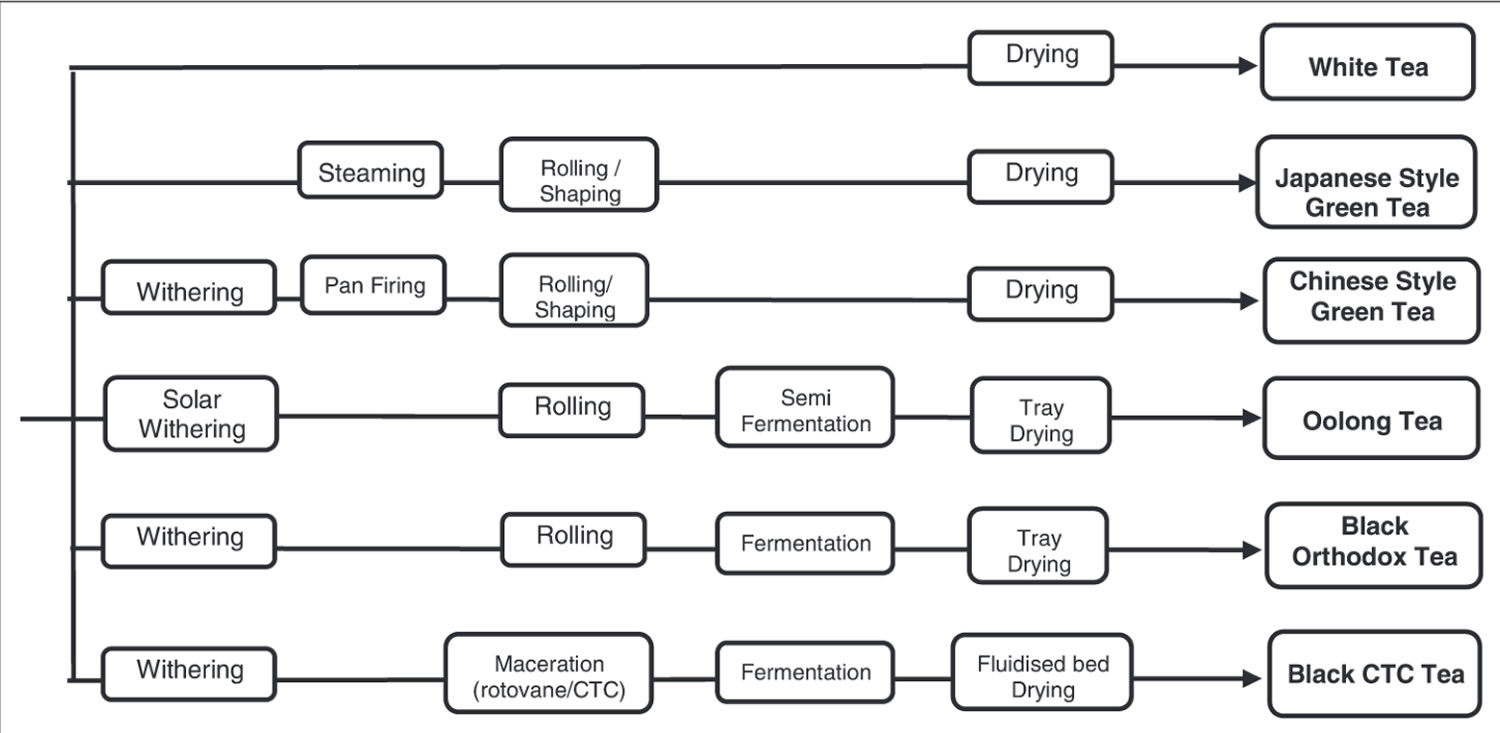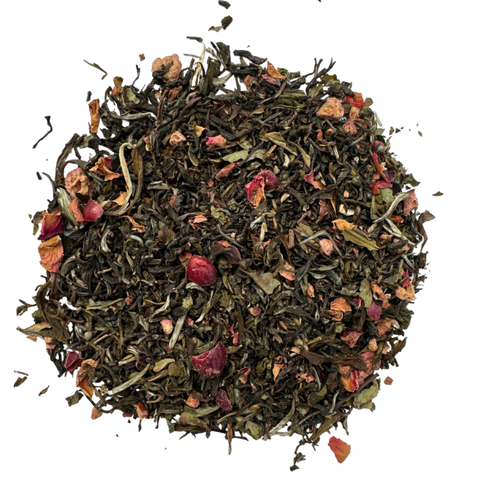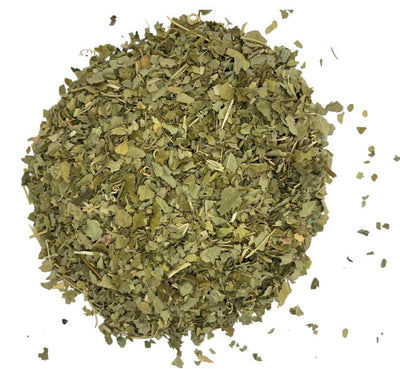Tea Types & Processing
There are six categories of tea: white, green, yellow, oolong, black, and dark (Pu-erh is a dark tea). The different types are categorised by the level of oxidisation or fermentation that takes place during the processing of the leaves and buds with white tea being the least oxidised and black being the most.
The Origin and Processing of Tea
Tea, cherished worldwide for its diverse flavours, originates from a humble shrub known as Camellia sinensis. This plant thrives in a subtropical belt, starting from eastern India, winding through northern Laos and Vietnam, and extending into southwestern China. Despite this singular origin, the tea we enjoy comes in several varieties—such as green, black, and oolong—all derived from the same plant.
The Influence of Nature and Technique
The distinct flavours and characteristics of each tea type result from a delicate interplay of factors. Plant variety significantly influences the taste, as different strains of Camellia sinensis bring unique attributes to the final brew. Additionally, growing conditions, including soil, climate, and altitude, further shape the tea's flavour profile, allowing each region's produce to stand out.
The Art of Processing
Post-harvest, the destiny of the tea leaves lies in their processing style. This is where the tea's journey truly diversifies.
- Green Tea: Preserved from oxidation to maintain its vibrant colour and fresh taste.
- Black Tea: Allowed to fully oxidize, leading to its darker hue and robust, rich flavours.
- Oolong Tea: Positioned between green and black in terms of oxidation, offering a complex taste that can vary widely.
Each processing method not only defines the visual and taste elements of the tea but also allows tea artisans to innovate, resulting in a vast array of options for tea enthusiasts.
While herbal and grain teas tempt with their own stories, it's the mastery over Camellia sinensis that marks the essential journey of traditional teas from leaf to cup.

Oxidation is what happens when the juices in the tea leaves react with oxygen in the air around them. As this happens, the leaves turn from green to brown. It’s exactly the same process that happens if you cut an apple or a pear and watch the flesh of the fruit turn from white to brown as it oxidises. The longer the leaves are allowed to oxidise the browner they will become and, when the tea is actually brewed, the darker the liquor will be.

Potential Health Benefits of Drinking Tea
Tea has long been celebrated not just for its rich flavours, but also for its potential health benefits. One of the key components contributing to these benefits is polyphenols, which are potent antioxidants found in high concentrations in certain types of tea.
Antioxidant Power
- Polyphenols: These antioxidants help combat oxidative stress in the body, which can reduce the risk of chronic diseases. Stopping the oxidation process early during tea production, particularly in green teas, may enhance these effects.
Heart Health
- Regular consumption of tea is linked to improved cardiovascular health. Antioxidants in tea can improve blood vessel function and reduce inflammation, potentially lowering the risk of heart disease.
Weight Management
- Some studies suggest that compounds in tea, such as catechins and caffeine, may aid in weight management by boosting metabolism and increasing fat oxidation.
Mental Clarity
- Drinking tea might enhance cognitive function. The combination of caffeine and L-theanine, an amino acid found in tea, can improve alertness and focus without the jittery effects often associated with other caffeinated beverages.
Digestive Aid
- Tea, especially those like oolong and peppermint, can aid digestion. These teas can soothe the digestive tract and relieve symptoms like bloating and indigestion.
While research continues to solidify these findings, many enjoy tea not just for its potential health benefits but also for its comforting flavours. Varieties like green tea, with its grassy undertones, or the smooth sweetness of oolong, offer not only a delightful drink but also contribute positively to well-being.
When comparing the caffeine content of tea to coffee, tea presents a milder option. Coffee tends to pack a caffeine punch, while tea generally contains only about one-third of that amount. This lower caffeine level makes tea an ideal choice for those seeking a gentler morning boost.
One of the benefits of tea's lighter caffeine load is that it can be enjoyed more frequently throughout the day without the jitters often associated with coffee. Many types of tea can also be steeped multiple times, maintaining their flavor while allowing for more cups without increasing caffeine intake significantly.
In essence, tea offers a more subtle and sustained energy lift compared to the sharper, more intense jolt provided by coffee.
Understanding Herbal and Grain Teas
While traditional teas originate from the Camellia sinensis plant, herbal and grain teas are crafted from a variety of herbs, flowers, and grains. These are often termed tisanes or herbal infusions, providing a clear distinction from the classic teas we know.
What Sets Them Apart?
Traditional teas, like black or green tea, are made exclusively from tea leaves. Herbal and grain teas, on the other hand, do not contain these leaves. Instead, these brews encompass a broad range of natural ingredients, each bringing unique flavours and benefits.
A Dive into Herbal Teas
Herbal teas have a long history, originally serving medicinal purposes. Common varieties include:
- Chamomile: Known for its calming properties.
- Mint: A refreshing infusion, perfect for aiding digestion.
- Rose Hip: Packed with vitamin C and a delightful tartness.
Beyond the well-known, explore herbal delights such as:
- Elderflower: Recognized for its delicate aroma and soothing qualities.
- Greek Mountain Tea: Beloved for its earthy tone and traditional medicinal uses.
- Chrysanthemum: Popular in various cultures for its sweet, floral flavour.
Exploring Grain Teas
Grain teas hold a special place, particularly in East Asian cultures, known for their comforting and rich profiles. Popular ones include:
- Barley Tea: Commonly enjoyed in Korea and Japan, often served cold in summer.
- Tartary Buckwheat: Offers a nutty flavour and numerous health benefits.
- Job's Tears: A sweet, subtle brew that's easy on the palate.
- Corn Silk: Known for its mild, sweet flavour and refreshing quality.
Key Differences
The primary distinction is the absence of caffeine in herbal and grain teas, making them ideal for those seeking a caffeine-free alternative. Unlike traditional teas, which rely heavily on oxidation and fermentation for flavour, herbal and grain teas shine in their natural, diverse taste profiles.
Enjoyment and Preparation
These teas can be enjoyed both hot and cold, with cold-steeping being a favoured method to unlock refreshing flavours. They are perfect for making large batches, enjoyably sipped from a pitcher on a warm day.
By immersing yourself in the world of herbal and grain teas, you'll discover a wealth of flavours that not only soothe but also invigorate the senses, offering a refreshing departure from conventional tea experiences.

Black Tea Processing
Black teas are 100% oxidized. We make oxidation happen by breaking or cutting the tea leaves.
To make black tea, the freshly picked leaves are allowed to wither for 18-20 hours to evaporate 30-35% of the water content. Next, the leaves are rolled or cut to break the cells and provoke oxidation.
Methods of Processing
There are two different methods of rupturing the leaf cells.
-
The ‘Orthodox’ Method: This traditional approach involves rolling the tea by hand or machine. The process breaks and twists the leaves, causing the juices to surface and react with oxygen. This method results in a variety of leaf sizes—large, medium, and small.
-
The CTC (Cut, Tear, Curl) Method: Invented in the 1930s, this technique is used to create small tea particles ideal for teabags. These smaller particles brew faster, delivering colour and strength more quickly, making them perfect for teabags.
Once the leaves have been rolled or cut, they are allowed to oxidize until they turn dark brown. To halt further oxidation and remove most of the remaining water content, the leaves are dried in hot ovens.
Flavour Profiles and Regional Varieties
The oxidation process, coupled with careful rolling and kneading, develops rich malty and tannic compounds, alongside fruity and chocolate flavours. This transformation gives black tea its characteristic robust body, making it perfect for pairing with milk, sugar, honey, and spices.
Black tea is celebrated worldwide for its diverse flavour profiles:
- Assam and Darjeeling (India): Assam teas are known for their brisk and malty taste, while Darjeeling teas offer nuanced and delicate flavours.
- Mao Feng and Keemun (China): These styles deliver baked plum and chocolate notes.
- Sun Moon Lake (Taiwan): Cultivars from this region are incredibly aromatic, with flavours of ripe cherry and spice, offering a richness that feels sweetened even when it’s not.
Historically, black tea gained prominence when it became the favoured drink of Britons in the 19th century, largely due to its resilience during long ocean voyages. As British colonies in India, Sri Lanka, and Kenya adapted to tea cultivation, black tea's adaptability to mass production solidified its global status.
Incorporating both traditional and modern techniques, black tea processing is a balance of art and science, yielding a beverage as diverse and vibrant as the cultures that enjoy it.
Notable Regions for Black Tea Production
Black tea enjoys a rich history and global popularity, with several regions recognized for their distinctive varieties. Among these, India, China, and Sri Lanka are particularly renowned.
India
- Assam: Located in the north-eastern part of India, Assam is celebrated for its bold, brisk, and malty black teas. The region's climate and geography contribute to teas that are perfect for a strong morning brew.
- Darjeeling: Nestled in the foothills of the Himalayas, Darjeeling is famed for its delicate and nuanced black teas. Often referred to as the "Champagne of Teas," these teas have a unique flavour profile that includes muscatel notes.
Sri Lanka
- Ceylon Tea: Sri Lanka, formerly known as Ceylon, offers black teas that range from full-bodied and robust to light and fragrant. The country's diverse climates allow for a variety of black tea flavours, catering to a wide spectrum of taste preferences.
China
- Anhui: Hailing from China's Anhui province, Keemun black tea is admired for its smooth texture and complex flavours, including hints of baked plum and chocolate.
- Mao Feng: Another prominent Chinese black tea, Mao Feng is known for its gentle sweetness and floral notes, making it a favourite among those who enjoy a more subtle taste.
These regions not only contribute to the global tea industry but also offer tea enthusiasts a rich tapestry of flavours and aromas to explore.

Black tea leaves
Green Tea Processing
Green teas are not oxidised at all. We intervene during processing to stop any oxidation.
"When we make green tea, we try to capture the green colour and the green character of the leaves. So, we must stop all-natural oxidation from taking place in the leaves and leaf buds. This is done by applying heat (dry heat, called panning, or steam) which kills the enzymes that would otherwise have allowed oxidation to take place. This application of heat is called ‘de-enzyming the leaf’ or ‘fixing the green’.
Once the leaves have been picked, they are panned or steamed to de-enzyme them, rolled or pressed (to develop the flavour), and then dried. The water content remaining in the leaves is approximately 2-3%.
The way in which the leaves and buds are rolled gives the leaves a particular appearance. For example, Long Jing green tea is pressed by hand into little flat needles in a wok, gunpowder is rolled by hand or machine into little pellets, Mao Jian is rolled by hand on bamboo baskets and so looks lightly curved or twisted.
Different countries will have different taste profiles for their green tea. For example, a green tea from China will taste differently to green tea from a Japan Sencha or Korean green tea.
When diving into the world of green tea, you'll find a variety of flavours and aromas that reflect their origins and processing techniques. Japanese styles like sencha and gyokuro are renowned for their deep umami sweetness. Sencha offers a fresh, grassy taste, while gyokuro boasts a richer, more intense flavour due to its shaded growth.
Chinese green teas, such as bi luo chun and tai ping hou kui, present a different palette. Bi luo chun is cherished for its fruity and floral notes, whereas the large, flat leaves of tai ping hou kui bring forth a mild, sweet taste with a hint of nuttiness.
Korean green teas, often less talked about but equally delightful, provide a gentle balance with their light, vegetal flavours and subtle sweetness. Each cup of green tea tells a story of its origin, capturing the essence of the land where it was grown and the careful craftsmanship of its makers.
Flavour Profiles and Varieties
Green teas can evoke an array of flavours, reminiscent of spring peas, fresh cut grass, or even a gently toasted hazelnut. Some varieties offer a unique umami sweetness, a characteristic especially prevalent in Japanese styles like sencha and gyokuro. Meanwhile, lighter Chinese styles such as bi luo chun and tai ping hou kui provide their own distinct nuances, the latter showcasing large, alluring leaves pressed flat as bookmarks.
Health Benefits
Stopping the oxidation process early is not only about preserving green tea's fresh flavour but also about retaining its potent polyphenols. These antioxidants are suggested to offer a range of health benefits, making green tea an appealing choice for both taste and wellness enthusiasts. While more research is needed to confirm these benefits definitively, enjoying green tea for its taste is always a rewarding experience."

Green tea leaves in a bowl
Oolong Tea Processing
Oolong is the most complicated tea to produce requiring great skill, experience and time to create the range of flavours, fragrances and liquor colours that make this tea so special.
‘Oolong’ means ‘black dragon’ and the name comes from traditional oolongs which have large, twisted dark brown or black leaves that can look exactly like dragons or serpents.
Oolong teas are partially oxidised, on a scale between approximately 20% and 70%. The tea maker can control the level of oxidation that takes place during manufacture.
There are two main types of Oolong tea:
- Dark brown open-leafed oolongs that have been allowed to oxidise up to 70%
- Green, ball shaped oolongs in the shape of tight pellets that have been allowed to oxidise to 20-30%.
To make the darker type of oolong, the freshly picked leaves are allowed to wither in sunlight for about 2 hours. During this process light oxidation begins to take place. The leaves are taken indoors where they are shaken and tumbled in a bamboo drum to lightly bruise the leaves after which they are spread on bamboo baskets and left to oxidise up to 70%. To stop oxidation they are panned, rolled to develop the flavour and then dried.
To make the green, balled oolongs, the freshly picked leaves are allowed to wither in sunlight for about 2 hours. They are then taken indoors, shaken and tumbled and allowed to oxidise up to 20-30%. They are then panned (to stop any further oxidation) and rolled. Finally, they are put inside cotton bags and tightly rolled and squeezed to form tight jade-green pellets before being dried.
*Learn more about Oolong Tea here.
Exploring Taiwanese and Chinese Oolong Teas
Taiwanese Oolong Teas
is renowned for its exquisite high mountain oolongs, which showcase a rich tapestry of flavours and aromas. These oolongs, sometimes visually reminiscent of green teas, are transformed through slight oxidation, unveiling creamy, buttery notes and a distinct floral essence.
-
Bao Zhong: Hailing from northern , Bao Zhong is celebrated for its intense jasmine fragrance, offering a delicate and refreshing tea experience.
-
Dong Ding: Reflecting a more traditional style, Dong Ding has a higher oxidation level, presenting a nutty profile with a richer body and a long-lasting finish.
-
Tieguanyin: Another classic, slightly more oxidized than its lighter counterparts, providing a well-rounded, nutty taste with a smooth, robust character.
Chinese Oolong Teas
In , the art of roasting plays a crucial role in crafting oolong teas, often imparting a unique depth and complexity.
- Wuyi Cliffs Oolong: Produced in the mountainous Wuyi region, these teas offer a robust, smoky flavour profile reminiscent of whisky, with notes of caramel, leather, and hints of mineral brine.
Discovering these varieties provides a taste of the intricate world of oolong, offering something for every palate—from light and floral to deep and smoky.

Pu-erh Tea Processing
Pu-erh tea is a dark tea from China’s Yunnan province. Pu-erh is the name of the market town where these teas have been bought and sold for hundreds of years.
Dark teas start as green teas and then go through a secondary aging process during which the character of the tea slowly changes. This is caused by micro-flora, bacteria, yeasts, penicillin, microbes and so on in the tea. This secondary, post-production process causes fermentation as well as oxidation.
While green teas and lighter oolongs are best enjoyed fresh, several white, black, and oolong styles can develop new depths with age. The aging of these teas allows them to shed their initial flavours and take on complex notes, such as the rich depth of varnished wood, old leather, and mellow earthiness.
Teas that undergo bacterial and fungal activity during aging are unique. Unlike the fermentation processes in beer or pickles, these teas don't yield alcohol or lactic acids, yet they are fermented nonetheless. This unique transformation is what sets them apart, creating distinct flavour profiles and aromas.
Pu-erh, one of the most famous fermented teas, begins its journey as a type of green tea. Over time, it transforms, offering drinkers a rich tapestry of flavours unattainable in freshly processed teas. Similarly, liu an is aged in bamboo baskets, which further enriches its taste, providing an experience that is as much about tradition as it is about flavour.
The significance of these teas extends beyond their taste. Some celebrated vintages are highly prized, fetching tens of thousands of dollars per pound at auction, underscoring their cultural and economic importance.
In contrast, Burmese fermented tea leaves are lactofermented and used in salads, illustrating the diverse methods and purposes of fermentation across different cultures. This highlights the unique standing of aged and fermented teas in the world of beverages, distinguishing them further from their non-fermented counterparts.
To make Pu-erh tea, a green tea is made from the leaves and buds of the local Camellia sinensis var. assamica found locally in the mountains of southern Yunnan This green tea is called ‘maocha’ meaning “light green rough tea” or “crude tea” and was created as a low budget tea. It is made by panning, rolling and drying the leaves in the sun. The tea is then steamed or dampened, compressed into cakes or left loose, and allowed to age in temperature-controlled and humidity-controlled conditions for several years.
Pu-erh tea is associated with weight control and we use Pu-erh tea for the base of our ever popular skinny tea.

Pu-erh tea leaves
White Tea Processing
White teas always go through very light natural oxidation.
The finest white teas are picked early in the spring before the leaf buds have opened and whilst they are still covered with silky white hair. When white tea is made, it is really important that the pickers use the utmost care to avoid damaging the cells of the leaves and buds which, when broken or bruised, start to oxidise.
Once picked the leaf buds and leaves are spread on bamboo baskets or mats and are left to wither and dry in the sun. Then, they are withered and dried on bamboo baskets indoors. The water content remaining in the leaves is reduced to 2-3%.
There is always a certain amount of very light natural oxidation in white teas, but we don’t do anything to cause it or to stop it. It’s a totally natural process making white teas the purest of all teas. White tea is light and blends well with a huge variety of fruits, botanicals, herbs and even other types of tea. An example is our White Tea and Rose.
Common Varieties of White Tea
White tea is celebrated for its minimal processing and elegance, allowing nature to craft its unique flavour profile. Here are some popular varieties that highlight its delicate nature:
-
Silver Needle: Known for its exceptional delicacy, Silver Needle is crafted from the tender, unopened buds of the tea plant. It boasts a soft sweetness reminiscent of marshmallows and carries the fresh, clean scent of linens.
-
Bai Mu Dan (White Peony): Slightly more robust than Silver Needle, Bai Mu Dan blends young buds with some leaves. This variety is cherished for its vibrant, floral notes, striking a balance between delicate and aromatic.
-
Gong Mei: Though coarser compared to the more refined Silver Needle, Gong Mei offers a unique taste. It presents a richer, fuller body, with hints of fruitiness, making it a favoured choice among those who appreciate a heartier white tea.
-
Shou Mei: Known for its fuller flavour, Shou Mei is made from more mature leaves. This gives it an earthier tone and a deeper colour, yet it maintains the subtle sweetness characteristic of white teas.
These varieties highlight the subtle art of white tea crafting, each offering a unique taste experience.

White tea and pomegranate
Yellow Tea Processing
Yellow teas go through a light oxidation stage to mellow and smooth the flavour.
To make yellow tea, the leaves are panned to de-enzyme them, then while still warm and damp, they are wrapped or heaped and left for 2-3 days. Then they are panned again and then re-wrapped or heaped and left for 3-4 days. Then they are panned for a third time to remove most of the remaining water in the leaves. The water content remaining in the leaves is reduced to 2-3%.
The wrapping or heaping stages hold water and warmth in the tea and these cause light oxidation to take place giving the tea a smoother mellower character than green tea has.
Exploring Unique Tea Styles Beyond the Main Categories
Tea is a world rich with variety, not just limited to the classic five categories. Here are some remarkable styles that challenge typical classifications:
-
Yellow Tea: Originating from China, this type of tea stands out due to its unique processing. It shares similarities with green tea but incorporates additional steps that involve smothering and sweating the leaves. This process results in a mellow, rounded flavour that's distinct from both green and white teas.
-
Korean Hwangcha: Though also referred to as yellow tea, hwangcha takes a different path than its Chinese counterpart. Its production process aligns more closely with oolong or black teas. The taste can often reflect these similarities, making it a fascinating blend that defies traditional categories.
-
First Flush Darjeeling: This tea from the Darjeeling region is often labelled as black tea, although its characteristics differ. Harvested during the year's first flush, it undergoes heavy withering but minimal rolling and oxidation. The result is a pale amber brew with fresh, piney notes that resist conventional classification as white tea or oolong.
-
Awabancha: Hailing from Japan, awabancha breaks the mold by being a pickled tea. Its distinct preparation involves fermentation, offering a unique flavour profile that stands apart from typical tea varieties.
These styles highlight the diversity and innovation in tea production. They remind us that tea is more than a beverage—it's a creative expression that often transcends conventional boundaries.
Understanding Chai: A Global Perspective
Chai is a versatile word that resonates differently across cultures. In Hindi, "chai" simply means "tea," derived from the Chinese term "cha." Saying "chai tea" thus humorously translates to "tea tea."
Masala Chai: A Southeast Asian Delight
In Southeast Asia, chai often refers to Masala Chai, a creamy concoction treasured for its rich flavours. This beverage is created by brewing black tea with a carefully selected blend of spices and herbs, often including cinnamon, cardamom, and cloves. It's then mixed with milk and sugar to achieve a balance of spicy and sweet flavours. The preparation of Masala Chai can vary, with some recipes including ingredients like ginger and peppercorns for added warmth and intensity.
Western Interpretations: A Modern Twist
In Western countries, the word "chai" commonly refers to a spiced version of tea, sometimes served as a latte. This modern twist often includes frothy steamed milk, comparable to a café-style drink. The spices remain similar—cinnamon, cardamom, and clove—but the preparation usually aims for an indulgent, smooth texture. Brands like Starbucks and Tazo have popularized this version, offering chai lattes that combine traditional flavours with modern-day coffee culture.
Global Variations
While these are two of the most recognized interpretations, chai's adaptability means it has many forms worldwide. In some Middle Eastern and African regions, tea is brewed with local spices and herbs, creating variations that reflect geographical and cultural preferences. Whether you prefer the traditional Masala Chai of India or a Western-style chai latte, each cup tells a unique story through its blend of ingredients and preparation methods.
Exploring Popular Herbal Tea Varieties and Their Origins
Herbal teas, also known as tisanes or herbal infusions, have an ancient lineage that parallels traditional teas. Crafted from a delightful mix of herbs, flowers, and grains, these brews have a history as rich as their flavours.
Commonly Enjoyed Herbal Teas
-
Chamomile: Known for its calming properties, this herbal tea comes from the dried flowers of the Matricaria chamomilla plant. Chamomile has been cherished across Europe and Egypt as a soothing beverage for centuries.
-
Peppermint: This refreshing infusion is made from the Mentha piperita plant and is native to Europe and the Middle East. Its bold, cool flavour has made it a global favourite.
-
Rose Hip: Derived from the fruit of the rose plant, these vibrant red hips create a citrusy brew. Known for a high vitamin C content, rose hip tea has been enjoyed in regions spanning from Europe to South America.
Unique Herbal Brews to Discover
-
Elderflower: Hailing from the elder tree (Sambucus nigra), this tea boasts a sweet and floral taste. It has been traditionally used in Europe for its potential health benefits and aromatic profile.
-
Greek Mountain Tea: Originating from the high altitudes of Greece, this tea is made from the Sideritis plant. Revered for its distinct taste and believed medicinal properties, it's sometimes compared to green tea.
-
Chrysanthemum: A staple in Chinese herbal medicine, this tea is crafted from dried chrysanthemum flowers. Its delicate aroma and slightly sweet flavour make it a popular choice throughout Asia.
Discovering these herbal teas connects you to diverse cultures and traditions. Whether you're drawn to the familiar comfort of chamomile or the exotic allure of Greek mountain tea, each cup is a journey through time and across continents.
Grain teas offer a unique twist on traditional tea, crafted from roasted grains rather than the familiar tea leaves. These teas have ancient roots and are a staple in certain Asian cultures, notably Korea and Japan. The process of making these beverages involves roasting grains like barley, tartary buckwheat, and Job's tears. This roasting enhances their natural flavours, resulting in a soothing and rich brew.
How They're Made
-
Selection of Grains: Choose your grain—options include barley, buckwheat, or Job’s tears depending on the desired flavour profile.
-
Roasting: The grains are gently roasted to develop a rich, toasty aroma. This step is crucial for extracting the unique flavours that characterize grain teas.
-
Brewing: Post-roasting, the grains are brewed in hot water, similar to herbal infusions, allowing the flavours to steep and unfold.
-
Serving Options: These teas are versatile, offering a refreshing taste when served hot or cold. For a chill beverage, they are ideal for cold steeping or serving over ice.
Global Enjoyment
Grain teas are particularly beloved in Korea, where barley tea—known as "boryeongcha"—is a household staple. In Japan, "mugicha," or barley tea, is commonly enjoyed, especially during the hot summer months. These caffeine-free drinks are perfect for serving in large pitchers and are cherished for their hydrating properties.
Whether enjoyed hot for comfort in winter or iced to refresh during the summer, grain teas have secured their spot in the world of traditional beverages, celebrated for both their unique taste and the cultural heritage they represent.

Yellow tea leaves
Tea processing is a complex and intricate process that requires careful attention to detail. Each step in the process plays an essential role in determining the final product's flavour, aroma, and appearance. By understanding the tea processing methods, you can appreciate the craftsmanship and skill that goes into producing your favourite cup of tea.
To enjoy your tea, you need the right teaware. Check out our extensive range of teapots, tea cups, and other tea accessories.







